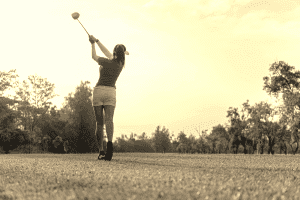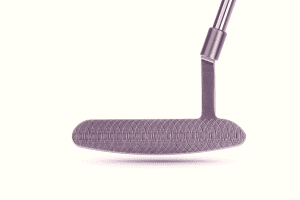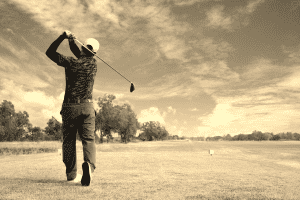Having a great short game in golf is critical to lowering your scores, and is probably the most important aspect of the game. Most shots in golf are taken within 50 yards of the hole, yet most golfers put much less effort into their short game than they do spending time hitting driver and long irons on the range.
Being able to chip the ball effectively and consistently will give you many scoring opportunities on the golf course. Better chipping will make you a better golfer, however it requires practice to hone in your chipping abilities. This guide will give you everything you need to become better at chipping, and lower your scores on the golf course.
Common Chipping Mistakes and how to fix them
To start improving any part of your golf game, it’s important to know where your flaws are. There are a few common chipping mistakes that many amateur golfers make, which prevent them from being more consistent and in turn, a great chipper. Make sure you evaluate what your common mistake is, so you know what you’d like to fix!
Poor ball position
When I was first learning how to play golf, I was taught that the ball should be in the back of your stance on any shot hit with a higher lofted club, even during chip shots. While this can work, golf is about being consistent and being able to repeat shots with ease. Leaving the ball in the back of your stance usually forces your hands forward awkwardly, which delofts the club.
The fix: Center the ball position
Make sure you don’t set the ball too far back in your stance, instead try and have the ball be more in the center of your stance. Keeping the golf ball in the center of your stance will discourage your hands from being too far forward. Your hands should fall to the club as naturally as possible. Keep your weight evenly distributed, and have a slightly narrow stance.
Check out this video from Chris Ryan that demonstrates this well:
Deceleration
Deceleration is the act of slowing down your swing through impact, which almost always ruins a shot. While hitting a chip, this can be devastating. One of the worst feelings is envisioning a great chip rolling right up to the cup, then during execution barely hitting the ball one yard. Deceleration causes issues in just about every golf shot, and needs to be avoided at all costs while chipping. Deceleration while chipping will cause you to either chunk a shot, or even worse, hit it very thin and cause it to sail past your intended target.
The Fix: Focus on your follow through
An easy way to stop decelerating through your shot is to focus on your follow through. Make sure you are able to deliver a full follow through and slight weight transfer to stop quitting on your shot. Placing an emphasis on a strong follow through will help you accelerate through the ball and hit more consistent chips.
Misusing Loft and Bounce
The loft and bounce of the club are both there to help you hit cleaner shots with your wedges. The bounce is the leading edge of your wedge, which helps produce forgiveness in your wedge shots. Amateur golfers tend to keep their hands too far forward on chip shots, effectively eliminating the bounce and significantly reducing the loft of the club. This forward pressing motion can cause you to hit much fatter, less clean shots and also makes it hard to get a good follow through on your shot.
The Fix: keep the club shaft neutral
Keeping the shaft more neutral allows the club to sit more naturally on the turf, and will help use the bounce and loft during your golf shot. The club will be able to function as designed from this neutral start point, allowing more forgiveness and consistency in your chip shots.
Here’s a great video from US Golf TV detailing this mistake and addressing how to fix it:
Trying to Help the Ball Into the Air
Many golfers who are new to the game will try to help the ball into the air with a scooping or flipping motion, which leads to many more problems than solutions. Hitting “up” on the ball is really only something you should do with your driver. “Helping” the ball into the air will ultimately make you thin the ball more often.
The Fix: Use a Downward Strike
It’s important to use a downward strike when hitting your irons, and this remains important when chipping. Keeping the club lower to the ground with a slight downward strike allows the loft and bounce of the club to do most of the work.
Chipping FAQ
What Club should I use when chipping?
I see this question pop up a lot, and frankly the answer is “it depends”. If you’re right up around the green it makes the most sense to use a Pitching Wedge or a 9 iron. These clubs have a bit less loft than a Gap Wedge or Sand Wedge, and will let your ball run more, which is perfect for a bump and run. It’s important to know you’ll get the ball in the air more on a higher loft club, and get less roll out.
If you have more ground to cover, around 20-30 yards, it probably makes more sense to use a Pitching Wedge or Gap Wedge. While choosing the club does impact your shot, I always recommend going with the shot you can hit the closest to the hole. A great go-to short game shot is incredibly valuable.
Chipping VS Pitching: What’s the difference?
Before we get into it, it’s important to know that there is a big difference between hitting a chip shot and a pitch shot. Here’s a quick outline on the differences between these two golf shots, which are both critical to your short game:
Chipping:
A chip shot is a low shot that will be executed just off of the green, either in the fairway or the rough with virtually no obstacles between the golfer and the flag (bunker, cart path, etc). A chip shot keeps the ball low to the ground and allows the ball to run up to the flag; if you have a lot of green to work with and nothing between you and the flag this is the ideal play.
Keeping the ball low and running gives the golfer more control over the outcome. A general rule of thumb is that the ball will be in the air for 1/3 of a chip shot, and roll out for the other 2/3 of the shot.
Pitching:
A pitch shot is used to put the ball higher in the air to get over an obstacle between you and the green, whether it be a bunker, a hill, some water, the cart path or otherwise. A pitch shot will land much more softly, and have significantly less roll out. Pitch shots are highly effective between 30 and 50 yards from the green, and can deliver a “dialed in” approach shot when used correctly.
7 Chipping Drills for A Better Short Game
Want to improve on your chipping skills? You’ll need to practice. Here are some of the top chipping drills you can do to hone in your short game and hit the ball close more consistently!
1. Find Your Landing Spot
Main Focus: Working on Distance control
This is a pretty simple drill that really helps you fine tune your chipping skills, making this one of my favorite drills to do when I want to practice. You can do this Find Your Landing Spot drill at the course and at home, making this a perfect utility drill.
It’s exactly what it sounds like. Finding your landing spot and then chipping towards it will help you gain feel and distance control on your chip shots.
At the golf course, put a few different physical targets down on the practice green, various distances from where you’ll be chipping; these can be anything from tees to ball marks- just something visual enough where you have a good target to hit toward. I recommend putting the targets anywhere from 6 feet away to 30 feet away to give you more variety. After the targets are in place, your goal is to get the ball to land at your target. Different distances often will require you to use different clubs during this drill, which helps you develop feel for many different situations on the course.
If you’re at home and want to do this drill, the idea is the same. At home, take a towel and fold it into a 1 ft x 1 ft square and place it about 6-8 ft from your chipping spot. The goal is to land the ball on the towel a few times in a row, then move the distance back. This should be done in the 6-25 ft range.

2. Down the Chute
Main Focus: Accuracy and Swing Path Improvement
Down the Chute is all about using alignment and the correct swing path for your chip shots. Making sure you take a “straight back” takeaway makes it so that your chipping swing isn’t flat, and requires less body rotation through the ball.
To practice this drill, put down 2 alignment sticks (if you don’t have alignment sticks, feel free to lay 2 of your irons down instead) and practice chipping toward a target while focusing on your swing path. Keeping a consistent swing path and swing plane will help your chips be more consistent and accurate.
3. Coin Chipping Drill
Main Focus: Clean Contact and Downward Strike
Chipping a coin requires precision and a downward blow to execute. If you struggle with clean contact when you chip, this is a great drill to practice inside while it’s raining to get a cleaner strike on the ball. This is meant to be done at short range, usually within about 5-10 feet of your target.
To practice this drill, put a plastic cup in the middle of a carpeted room, and scatter coins (quarters or similar) around it in a circle, about 5-10 feet from the cup. Practice trying to hit the coin into the cup using a short backstroke, focusing on precision and clean contact.
Enough practice with this drill will make the golf ball seem 5x bigger and 10x easier to hit.
4. Chip At A Chair
Main Focus: Trajectory Control
Chipping trajectory can tell you a lot about the way your ball will roll out once it lands. A higher and softer trajectory will have much less roll out than a low to the ground chip shot. Chipping at a chair can actually give you a lot of insight on how your chips fly, and can help you control their trajectory which will translate to more accuracy on the course.
This drill can be done either inside or outside, although it’s much safer to practice it outside; if you do this drill inside, make sure there’s nothing that can be damaged behind your chair!
To do this drill, put a chair about 5 ft in front of you and set up to hit a chip. Envision 3 different sections: lower, middle and upper. Hit a normal chip shot and see which section it naturally goes through; this is good information to have, and it will act as a baseline to your other chip shots.
After you’ve got a standard shot in mind, play around with the ball position within your stance to see how it changes trajectory; further back in your stance should produce a lower chip into the lower section, while a forward ball position will produce a higher trajectory chip that will go into the upper section of the chair.
You can also change this drill by moving further away from the chair and using a different stroke or a different club, rather than changing the ball position. Play around with this, and figure out what feels the best for you.
Having a solid foundation on trajectory control will give you even more confidence on the golf course next time you have a tough chip to make.
5. HORSE
Main Focus: Distance Control, Accuracy, and Competition
Growing up, I absolutely loved playing horse on the basketball court with my friends. Hitting different shots from different distances hones your skills and allows you to show off (or get a reality check) with your friends. For golf, the concept is exactly the same and can be used to as a fun chipping competition with a friend.
For golf, the rules are simple and easy to follow:
- The first player to hit picks a spot to chip from and a target to hit to. They get one try to get the ball within 2 ft of the target for the shot to be considered “good”. If the shot is good, the second player must hit from the same spot and also make the shot “good”, otherwise they take a letter.
- If the first players shot is not “good”, then the second player picks a different spot. If either player cannot duplicate a “good” chip, then they get a letter.
- The first player to get all 5 letters of HORSE loses the game.
Ideally, this game is played on the practice green at the golf course, but can be done at home too. IF you can do it at the course, it’s fun to add a rule that if you sink a chip the other player gets a letter!
If you want to practice with a friend and put some pressure on yourself to simulate the pressure on the course, this is a great practice drill.
6. Par 18 Chipping Game
Main Focus: Competition, Accuracy, and some putting
Incorporating some variety into your chipping drills will make it more fun to practice, and this Par 18 Chipping game can be done alone or with a friend!
The idea is simple: around a practice green, set up 9 different “tee boxes” to hit chips from; make sure theyre from different angles and distances to make it more of a challenge on yourself. Each of the 9 shots is considered a Par 2 Hole, and your goal is to get it in within 2 strokes. This game helps you hit chip shots with distance control and accuracy in mind, and then gives you a chance to putt the ball into the cup!
Try playing this game weekly or more to see a pretty noticeable improvement in your chipping abilities.
7. Hula Hoop Drill
Main Focus: Landing Spot, Accuracy, Distance Control
This drill focuses on all the key areas of the chip shot: where you should land the ball, how accurately, and how far. This is another really straight forward drill that can help you hone your short game in to hit much better approaches to the pin.
To do this drill, place a hula hoop on the green to be your designated landing spot. Start from about 5-10 yards off the green, with the goal of landing the ball inside the hula hoop. Once you make a few in a row, drop back another 5 yards or so and repeat; you can do this drill up to about 25-30 yards from the hula hoop.
Here’s a great video demonstration:
Final Thoughts
Chipping and short game in general take practice and hard work to be great at. It’s important to know what part of your game you need the most work on, and act appropriately. Using golf chipping drills is a great way to perfect your craft and put yourself into scoring positions on the green. If you practice for a couple hours a week you’re sure to knock a few strokes off your rounds.
I hope you enjoyed this post! Want to read more? Check out our post on the best golf rangefinders this year!









